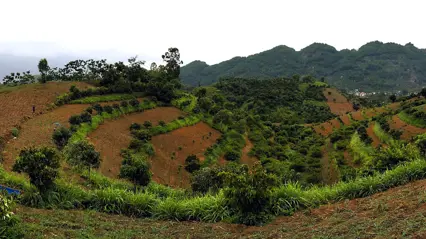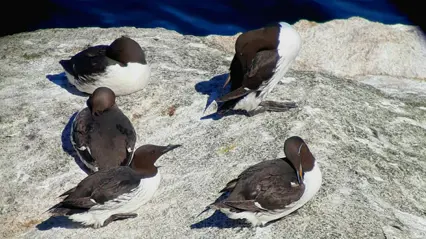
Agroforestry on sloping lands: A sustainable way forward
Farming on slopes feeds nearly a billion people, but often leads to soil erosion and degradation. A new PhD thesis from the Swedish University of Agricultural Sciences (SLU) suggests intercropping trees, crops, and grasses as a sustainable solution.

Guillemots prefer predictable foraging grounds
Common guillemots tend to seek out areas where the availability of fish is stable, even if the amount is small – a strategy that may leave them vulnerable as environments change. Using sailing drones and GPS transmitters, Astrid A. Carlsen has mapped how guillemots and razorbills search for food.

Use our research infrastructures
Research infrastructures at SLU are also available for researchers at other universities or companies. Maybe we have solutions that suits your research?
Most recently published projects
-
Sustainable Nutrients
Developing sustainable nutrient management practices in the Gulf of Bothnia. -
Waste conversion by insects: validation of a new method for improved performance
The bioconversion of biowaste using larvae of the black soldier fly (Hermetia illucens) is a novel technology that has been gaining prominent attention worldwide. -
The hunt for the perfect castration in horses
Most stallions are castrated, mainly for husbandry purposes. Despite being the most commonly performed surgical procedure in horses, there is a lack of established best practice. The aim of this project is to provide evidence-based guidance to veterinarians and horse owners.
-
Insects could be key to more sustainable animal feed
Insects are being highlighted as part of the solution for a more circular food production system. But what needs to happen for them to become a natural part of the feed chain? SLU researcher Cecilia Lalander answers questions about the potential of insects in a sustainable and circular food system. -
The price of perfection: Opting out of variety - a danger to animal immunity and survival
For thousands of years, humans have been controlling the breeding of dogs, horses and farm animals. Despite the benefits, this has led to unexpectedly high risks for the animals. With knowledge from research, now might be the time to re-evaluate breeding decisions. -
Scientists map aspen tree genes across seasons, creating a detailed genetic roadmap
Aspen trees follow a precise annual rhythm, shaped by the changing seasons. Researchers at UPSC have mapped this natural calendar at the genetic level, comparing trees grown outdoors and in the lab. Their study offers a detailed look into the molecular choreography behind the trees’ seasonal life.
-
How medicine residues in water affect young salmon
Imagine you are a young salmon making a long and dangerous journey from the river to the sea. -
Mapping bird flu risks will prevent future outbreaks
Since 2020, bird flu has affected around twenty food-producing poultry farms in Sweden, leading to the death or culled of nearly 2.4 million poultry. -
Pests and pathogens cause devastation in nature reserves
It may be tempting to perceive damaged forests as primarily a problem for the forest owner or the industry. A factor affecting price on wood, but of limited importance to society.